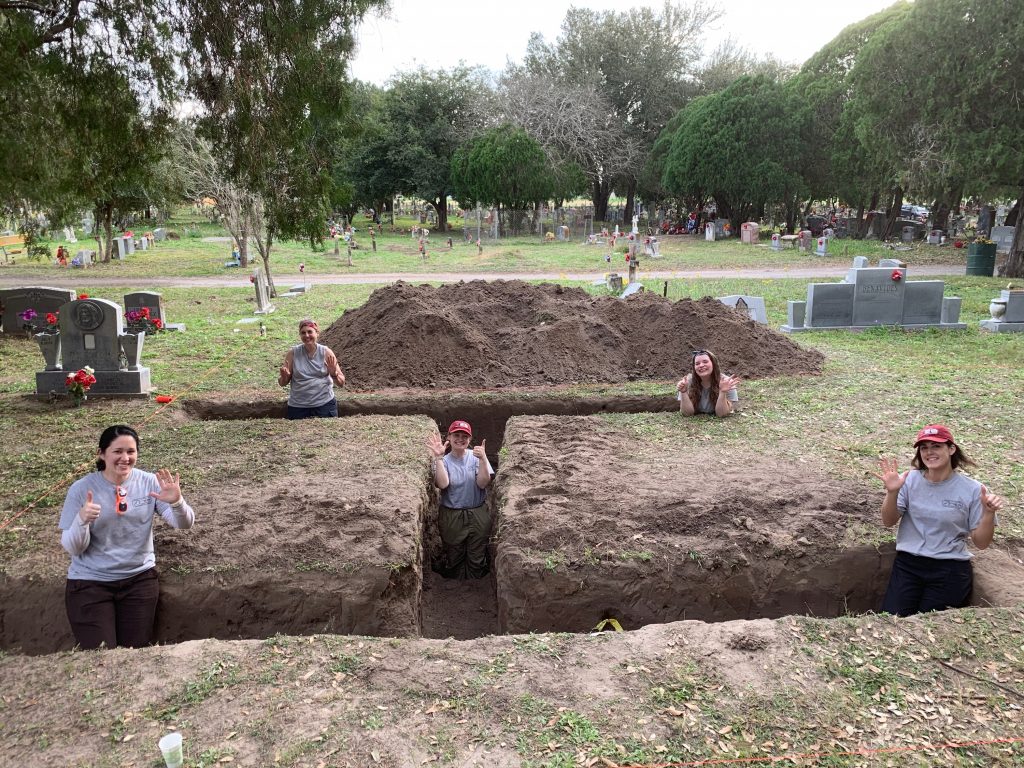This morning brought the team to a local ranch where we were able to participate in a search and recovery exercise with Border Patrol and the Sherriff’s Office. I was very excited to participate, as part of my last trip to South Texas with the Beyond Borders team this past May focused on search and recoveries. I’m not sure if I was more excited because it reminds me of my first trip, or maybe it’s because I have had not had the time to reflect on the effects of this season, but something about participating in searches really resonates with me. I feel a closeness in walking the same paths that migrants are taking and observing materials they left behind. Water bottles, sweaters, and jackets – all necessary for the journey, and all items that we carry around ourselves. It’s a reminder that these are living and breathing people, with wants and needs just like our own. I was happy to be able to share the experience with Sammi, Sidney, and Arden, not only for the physical act of performing a search, but in all the other parts that encompass it: the sandy soil that requires a little more effort to walk in, the various spiders and wildlife we come into contact with, the mesquite and cacti that have to be dodged, the feeling of being completely alone and not knowing where you are because everything looks exactly the same. I have presented on our previous trip a few times over the most recent semester, but hearing about searches and actually doing them are completely different things. The team was even fortunate enough to be covered in ticks by the time the search was over – a truly authentic part of the search and recovery experience! Though we only participated in the search and recovery exercise in the morning, I feel like the whole team was able to take something away from it. A quote from Sister Pam that I stated in my final reflection post from last season still applies here, “You become different people when you put your feet in other people’s shoes…it changes you”.
Latest Posts
Day 7: Change of Pace
Our day seven began as normal: getting to Sacred Heart at 7:30 and jumping right into digging. Our new area is quite large, so we are all motivated to work as efficiently as possible to clear it. We began the day by extending our two long trenches and adding a third in the middle. As we move down, we will cut across perpendicularly while continuing to extend the long ones.
Long story short: we have moved and will continue to move a lot of dirt.

While we love the work, we welcomed a change of pace today when Dr. Spradley said Deputy White needed a team to go on a search with him at a local ranch. We were set to leave at nine, so we set a timer for thirty minutes and got as much dirt moved as we could before it went off. Then, we headed out to the ranch.
Once inside the gate, we were met by two Border Patrol agents. We went to the area of interest and began to search.
When you take a crime scene investigation course, or even an introduction to forensics course, you learn different search methods: line searches, spiral searches, grid searches, etc. None of that training prepared me for searching this ranch. Walking ten feet in one direction is basically impossible due to the brush-filled terrain. If you kept up with the blog from the Summer 2018 search season, you have a better understanding of what I am talking about. If not, start here. Dr. Latham and Angela are the only ones who have done a search like this before, so the rest of us were learning as we went.
As I was searching, I came up with a system where I would walk from one landmark to another before moving forward: jacket to water bottle, water bottle to large cactus, large cactus to broken branch. This was a way for me to try to keep the main area in mind and to not wander off. I had my phone, but with no signal it would not have done me any good. At one point there was no one within my line of site. It was high noon and the visibility was as good as it could be. I couldn’t see Sammi’s white jacket or Dr. Latham’s red bandana. When migrants traverse this area it’s most often in the dead of night. I cannot imagine trying to navigate the rough terrain in total darkness, no compass, and no idea of where to go. I was thankful we did not have far to go and were able to stay relatively close to each other.

After we finished our search, we returned to Sacred Heart and found out the Brooks County Judge had brought everyone pizza for lunch. We took a small break to eat and then continued in our digging efforts. We worked for a few more hours but called it an early day so that we could get cleaned up before heading out to La Copa ranch where our Texas State colleagues are staying. The people who run the ranch (The Ed Rachal Foundation) were kind enough to throw us a barbeque! We were able to eat and drink with those who we normally only get to see in the field, offering a nice break from our day-to-day efforts in the cemetery.
We only have two days left in the field, and our plan is to get as much done as we possibly can while still remaining confident in our work.
Thanks for continuing to follow our progress!
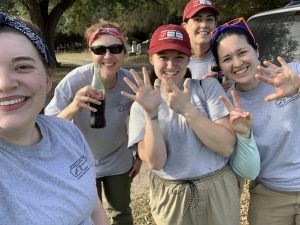
Day 6: Cleared
Day 6. We are officially more than halfway done with our trip here in Falfurrias. Yesterday gave our bodies time to recharge and showed us a broader scope of the migrant crisis. Even though some days felt like we were barely moving inches of dirt, our renewed sense of energy allowed us to finish our second root-filled section before lunch and move on to our third, and largest section yet. After dealing with enough roots to last all of our lifetimes, we were excited to find that our new section had very few roots, and areas with nice, soft soil.
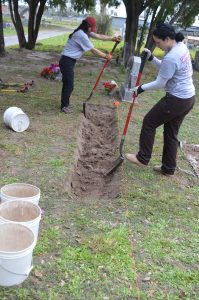
Unfortunately, little roots meant no tree cover, and we were exposed to the sun on the hottest day of our trip thus far. Humidity levels were also high, and there were a few drizzle showers in the morning. We decided to tackle our large area by making two large trenches on either side and then shorter trenches perpendicular to those, much like rungs on a ladder.
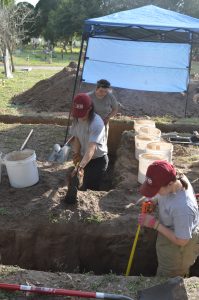
Deputy Sherriff Don White was kind enough to help us move a lot of the dirt we were digging, allowing us to continue our trenches with fewer interruptions from emptying buckets – Thanks Deputy Sherriff White! The heat required more frequent water breaks, and by lunch, all of us were soaked in sweat and covered in dirt. Despite this, our team decided to take a later lunch than usual because we were so motivated to continue the work we came here to do – recover the remains of migrants who have been buried
unidentified so hopefully, one day they can be returned home, and their families will have the answers they most certainly wish for. By the end of the day, we reached our goal of finishing the two trenches left in our second (root-filled) section, and digging three trenches in our newest third section.
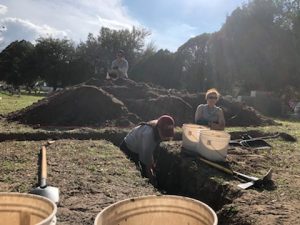
Even though the UIndy team has not made a recovery yet, we know the work we are doing is important to the greater Beyond Borders/Operation Identification project. Every area we clear is one less that future teams have to worry about searching. Every area cleared means that focus can be put on other areas of the cemetery that have not been searched. This season has not been easy – there have not been markers showing us where the unidentified are likely to be buried, and there seems to be no consistency in where remains are found. We have had to rely on past experiences with recoveries at Sacred Heart, as well as Ground Penetrating Radar (GPR), which can detect disturbances in the soil, but does not guarantee that these disturbances are the result of human burials. This means that the areas currently being searched are the areas considered more likely to have unidentified migrant remains. Often times this leads us to corners of the cemetery, which are considered undesirable locations to sell to the public, or areas between plots that may not be big enough for standard coffins. So even though we have not made a recovery, we remain determined to check every area we possibly can while we are here, because we know that there are more remains at Sacred Heart just waiting to be found. Our bodies may be tired, but our passion for this initiative keeps us going. The unidentified deserve to have a name, and their families deserve answers. Six days down. We have three digging days left, and I can guarantee you that this team will use every minute moving as much dirt as we possibly can.
Thanks for reading!
